PEARS For Your Aorta: Not Just Another Fruity Idea
Overview: The PEARS procedure is an acronym for a new method, involving open heart surgery, for treating proximal aortic root dilation and represents a novel, personalized approach - utilizing an external stent - to address a complex and often lethal disease of the aortic root.
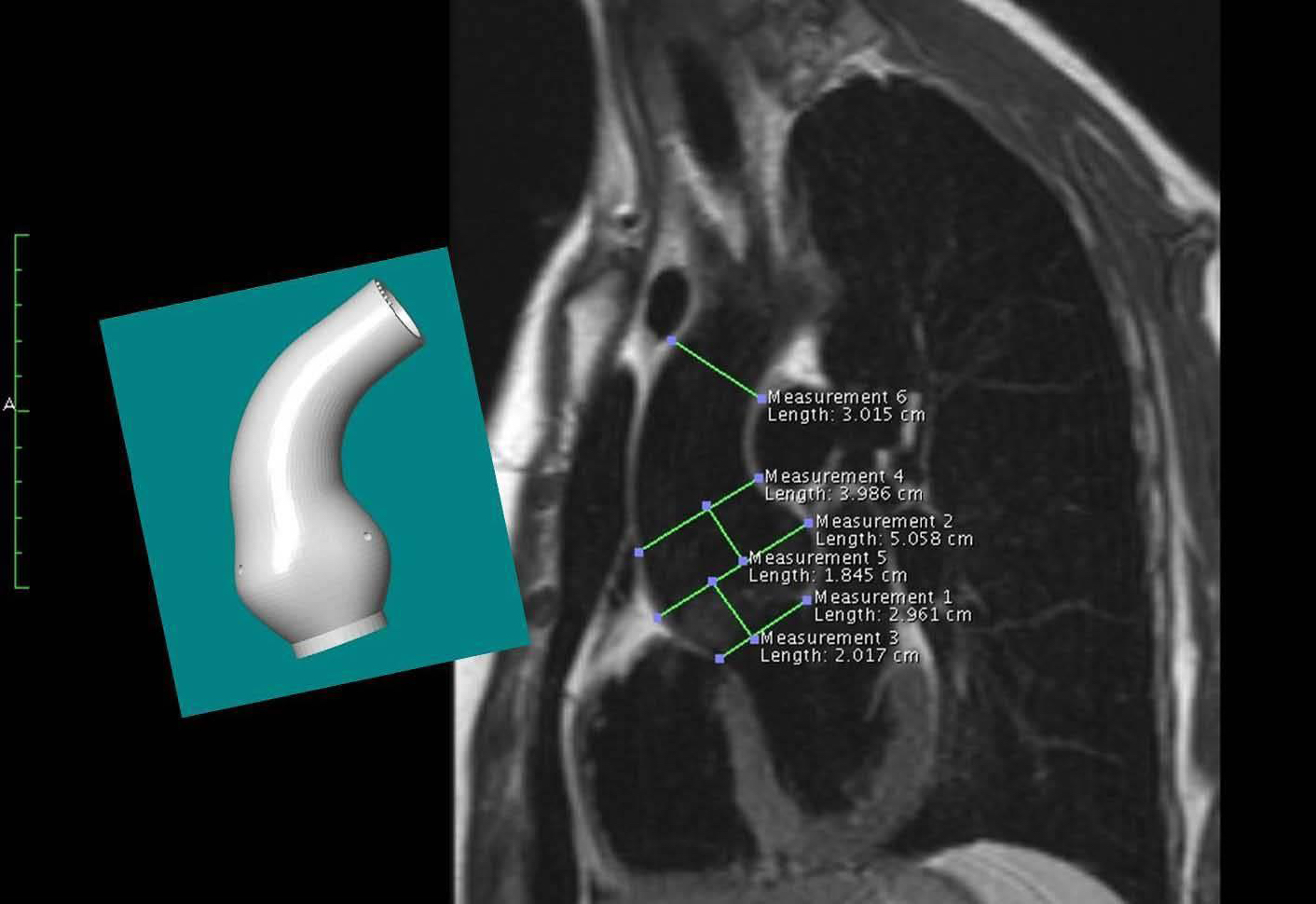
Introduction
We are all familiar with the story of Isaac Newton and the falling apple which we learned in school.
In the 1752 edition of Memoirs of Sir Isaac Newton’s Life written by William Stukeley, we are told about a scholar sitting under an apple tree who is struck in the head one day by a falling apple. The sudden act of being hit in the head by the apple apparently inspired a stroke of insight by young Isaac Newton to better comprehend the concept of gravity and how it relates to the earth, moon, sun and universe as a whole.
Perhaps not so apocryphal, but let me introduce you to Tal Golesworthy - a boiler engineer with Marfan Syndrome, who in a stroke of genius, devised a revolutionary plan to fix his own heart problem - and the heart problems of many others like him (called the PEARS procedure).
Although “PEARS” are a different sort of fruit than an apple, there are echoes of Sir Isaac Newton in Mr. Golesworthy’s tale.
Wheatley’s Aortic Rule #1
Before we get started, however, I want you to remember Wheatley’s Aortic Rule #1:
You have to understand aortic anatomy first before you can understand the cure.

Mr. Golesworthy has Marfan Syndrome. This genetic disorder, which can be inherited, involves a defect in the DNA which encodes for certain elastic proteins in the body. Patients with Marfan Syndrome are predisposed to develop a number of health problems related to body parts which have a high concentration of elastic tissues, such as the joints, eyes and aorta.
Recall that the aorta expands and contracts with every heart beat. The repetitive strain of continually expanding and contracting over 20, 30 and 40 years can lead patients with Marfan Syndrome and other similar genetic disorders of elastic tissue to develop localized dilations of the aorta.
One of the most frequently affected sections of the aorta in patients with Marfan Syndrome is the aortic root.
Anatomy of the Aortic Root
Aortic root aneurysms are not a problem which develop exclusively in patients with Marfan Syndrome. Patients without Marfan Syndrome, and without any known genetic disorder, can also develop aortic root aneurysms.
However, aortic root aneurysms occur frequently in patients with Marfan Syndrome and in patients with other inherited defects such as Loeys-Dietz syndrome.

The aortic root [A on the diagram to the right] is a very complex anatomic structure which is located in the mid-chest behind the breast bone (sternum). The aortic root is complex because there are a lot of things going on in such a compact space. The aortic root is physically where the aorta connects to the heart. People tend to think of the aorta and heart being generally lumped together into a general concept. But, in fact, the aorta and heart are completely distinct anatomic elements. The aortic root, therefore, is the physical “joint” where the aorta (“pipe”) connects with the heart (“pump”).
Located within the aortic root proper is the aortic valve (with aortic valve leaflets which extend up into the root when the aortic valve is open), the Sinuses of Valsalva (which is a natural bowing-out of the aorta adjacent to the three distinct aortic valve leaflets) and the openings of the left and right main coronary arteries (which allow blood to be transported to the entire heart muscle).
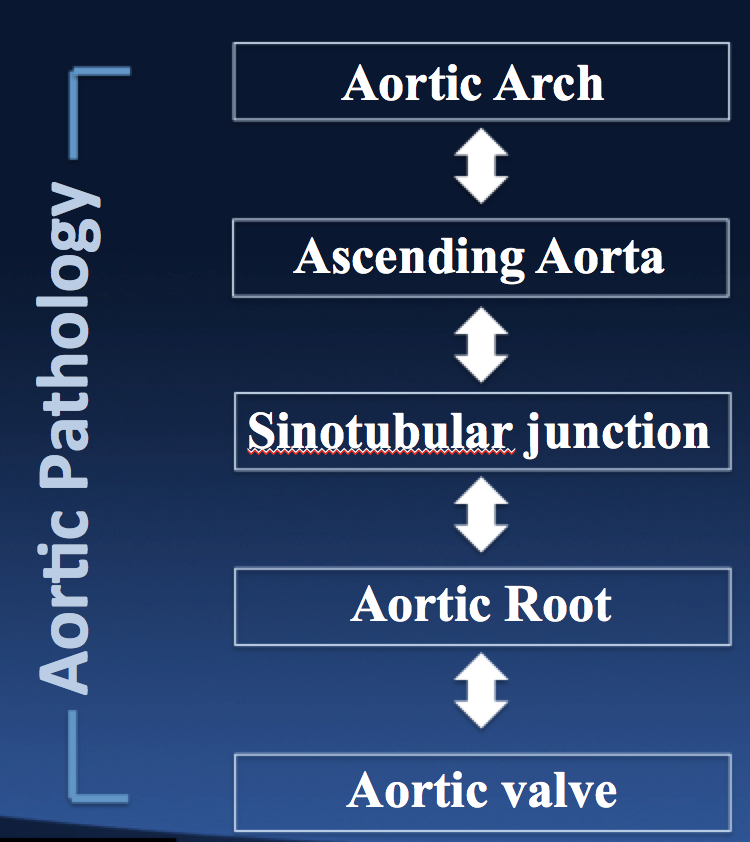
When I am sitting down with a patient and their family for the first time to discuss their aortic root problem, I remind them of Wheatley’s Paradox of the Heart. This paradox is that even though the heart is full of blood and pumps blood, the heart muscle which does the pumping of the blood is not nourished by the blood inside the chambers of the heart.
Recall that there are four distinct chambers within the human heart: right atrium, right ventricle, left atrium and left ventricle.
Each of these chambers serve a purpose, but every heart beat involves filling of a heart chamber and emptying of a heart chamber as blood traveling through the heart is first pumped to the lungs to exchange carbon dioxide for oxygen and then pumped to the body for the purposes of providing oxygen-rich blood to all the tissues and organs of the body.
The primary way that the heart muscle (pump) receives revitalizing oxygen-rich blood is in fact not from blood within the heart chambers, but instead, it receives nourishing blood from a complex network of arteries which are located on the outer surface of the heart - called coronary arteries.
The coronary arteries on the outside of the heart are organized like the tree trunk and its branches. There is a main trunk to the tree and numerous branches. Like a tree, with every branch from the tree, the tree trunk tapers in size. The heart has a left main coronary artery and a right main coronary artery - one for each side of the heart.
The origin, or opening, of each coronary artery is located within the aortic root and are located just above the aortic valve. The important point to remember is that the health of the heart muscle relies on the ability to receive blood from surface arteries which “plug-in” to the aortic root.
Point being: an aneurysm in the aortic root affects many vital structures including the heart indirectly through the coronary arteries, not just the aortic wall itself.
Aortic Root Surgery
Successful surgical treatment of the aortic root must address three critical components:
-
Achieve or maintain a fully functional aortic valve.
-
Preserve blood flow to the left and right main coronary arteries.
-
Address the structural weakness of the walls of the aortic root.
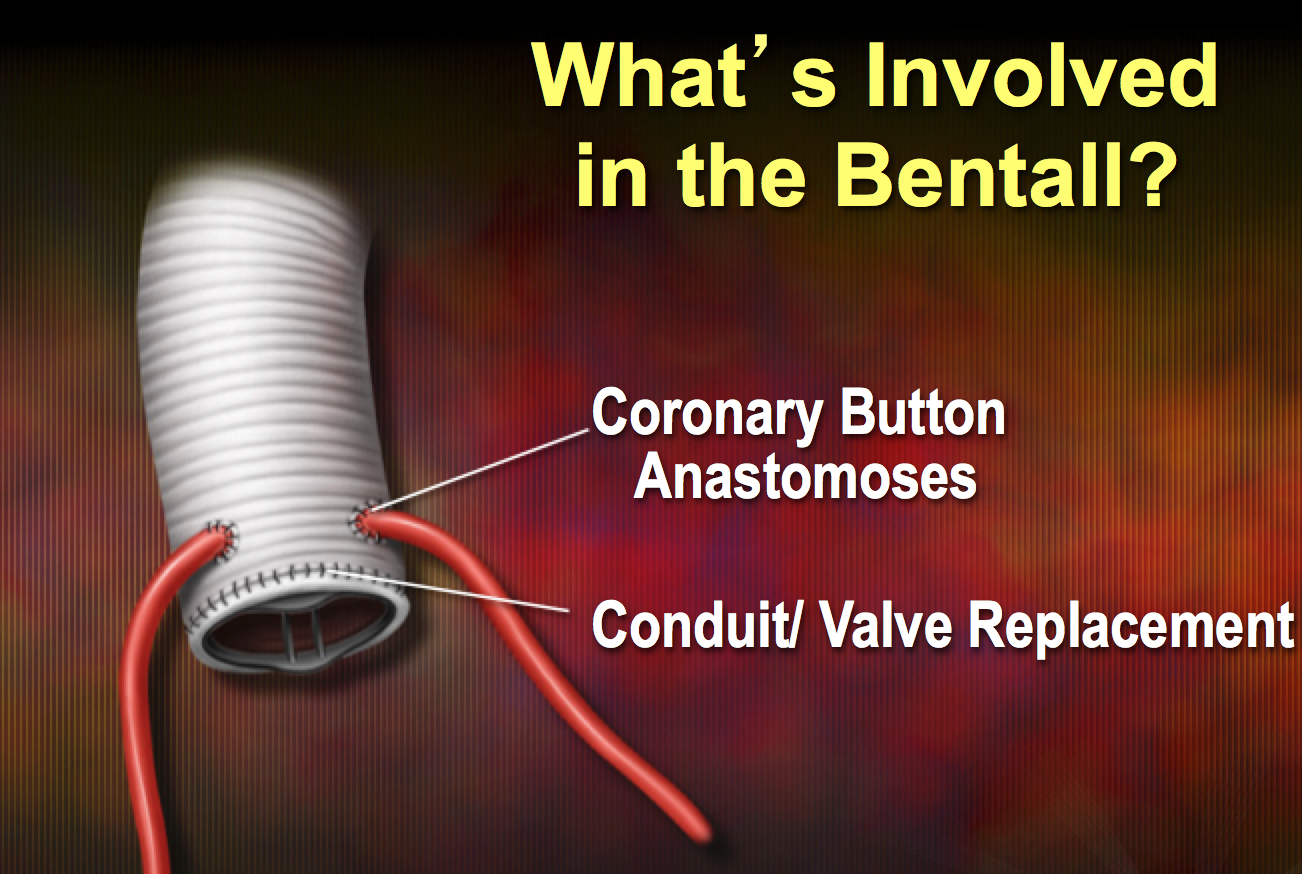
The current surgical approach to aortic root aneurysms involves three parts: 1) cut away the aortic wall because it is diseased and weakened and use a synthetic surgical graft to physically replace it, 2) preserve or replace the aortic valve and 3) reattach the left and right main coronary arteries into the new synthetic surgical graft.
This is called a Bentall procedure if the valve is replaced, and a valve-sparing root replacement procedure if the patient’s own aortic valve is preserved.
The PEARS Procedure
Mr. Golesworthy, being a boiler engineer, viewed repair of the aortic root from a different perspective. [Kind of like how Sir Isaac Newton did when the apple hit him in the head.]
He became intimately interested in aortic root aneurysms, because he himself developed an aortic root aneurysm. As he researched different surgical treatment options, he became convinced that there had to be a better option.
With that in mind, he embarked upon a project to develop a new surgical approach and technique to treating aortic root aneurysms - first and foremost, as a means of saving his own life.
As he states in his TEDx Talk, aortic root aneurysms represent a standard plumbing problem. Pipes of all sorts develop bulges and outpouchings all the time. When this happens, engineers and repair teams simply wrap some tape around the pipe and the problem is solved.
From his engineering background, he thought to himself that perhaps the aortic root aneurysm didn’t need to be removed, but could simply be externally supported instead.
Sounds simple, right?
This is where things become interesting. The punchline is that not only did he did in fact create a new surgical option, called the PEARS procedure, but he also became the first person in the world to receive the procedure and is still alive to tell the tale.
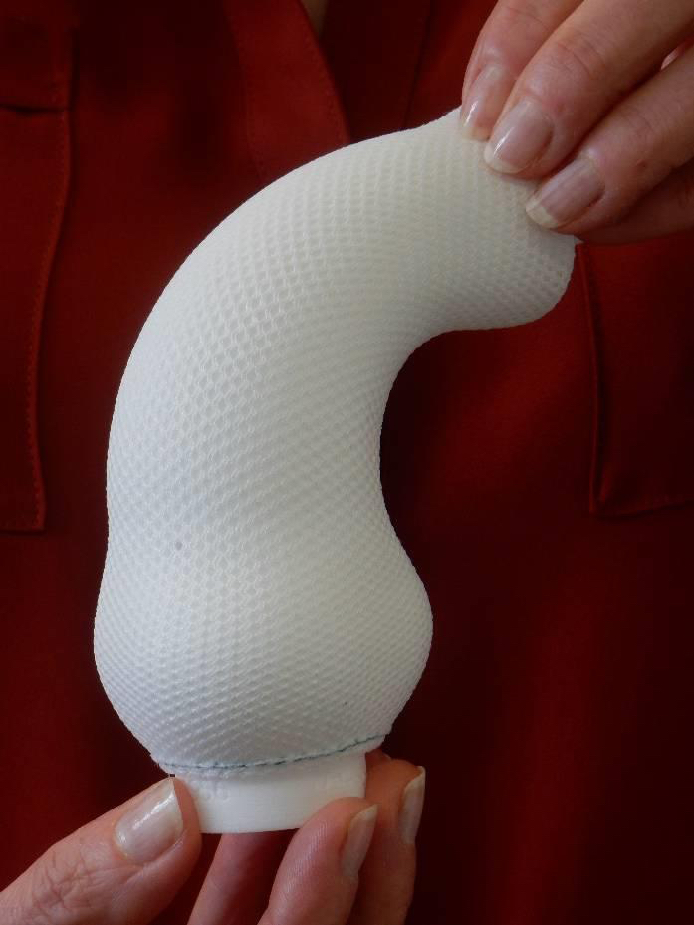
The PEARS procedure is an acronym for Personalized External Aortic Root Support.
The procedure is personalized because it involves 3D printing of an external support skeleton from detailed imaging of a patient’s own aortic root anatomy.
This personalized external support system is an external stent that is placed around the aortic root as a means of preventing continued aortic root expansion.
Readers of this blog are familiar with other types of aortic stents that are used to treat aortic aneurysms (however, not the aortic root). These aortic stent-grafts are placed inside the aorta and treat the aneurysm from this inside. The PEARS procedure involves surgery to place the 3D-printed exostent on the outside of the aortic root.
The advantages of this external support approach are that the PEARS procedure can be performed (in general) without putting the patient on the heart bypass machine - also called “beating heart surgery”. It still involves open heart surgery and opening up the breast bone, but the benefits of not having to stop the heart can lead to a quicker recovery for the patient.
As of March 2017, 97 patients ranging from patients in their 20’s to 60’s have received the PEARS procedure at numerous cardiac centers, including centers in the UK, Poland, Czech Republic, Belgium, New Zealand and Holland.
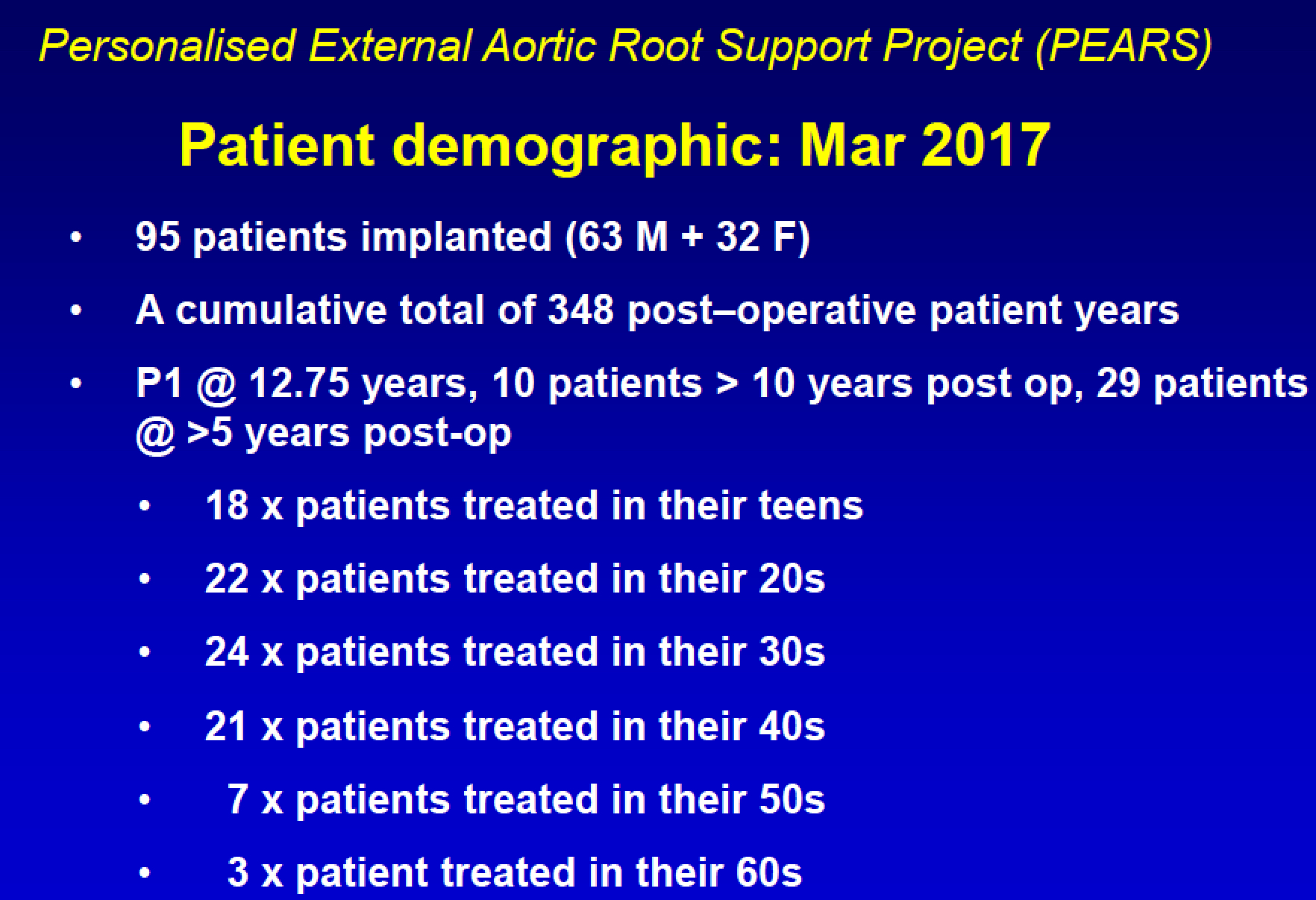
As you can see from the graphic, Mr. Golesworthy was the first treated patient almost 13 years ago and is doing well. Ten patients have over 10 years of follow-up and 29 patients have longer than 5 years of follow-up.
It is unknown how long the PEARS procedure will last, but early indications is that it is a durable procedure based on a limited number of subjects.
Who is a Candidate for the PEARS Procedure?
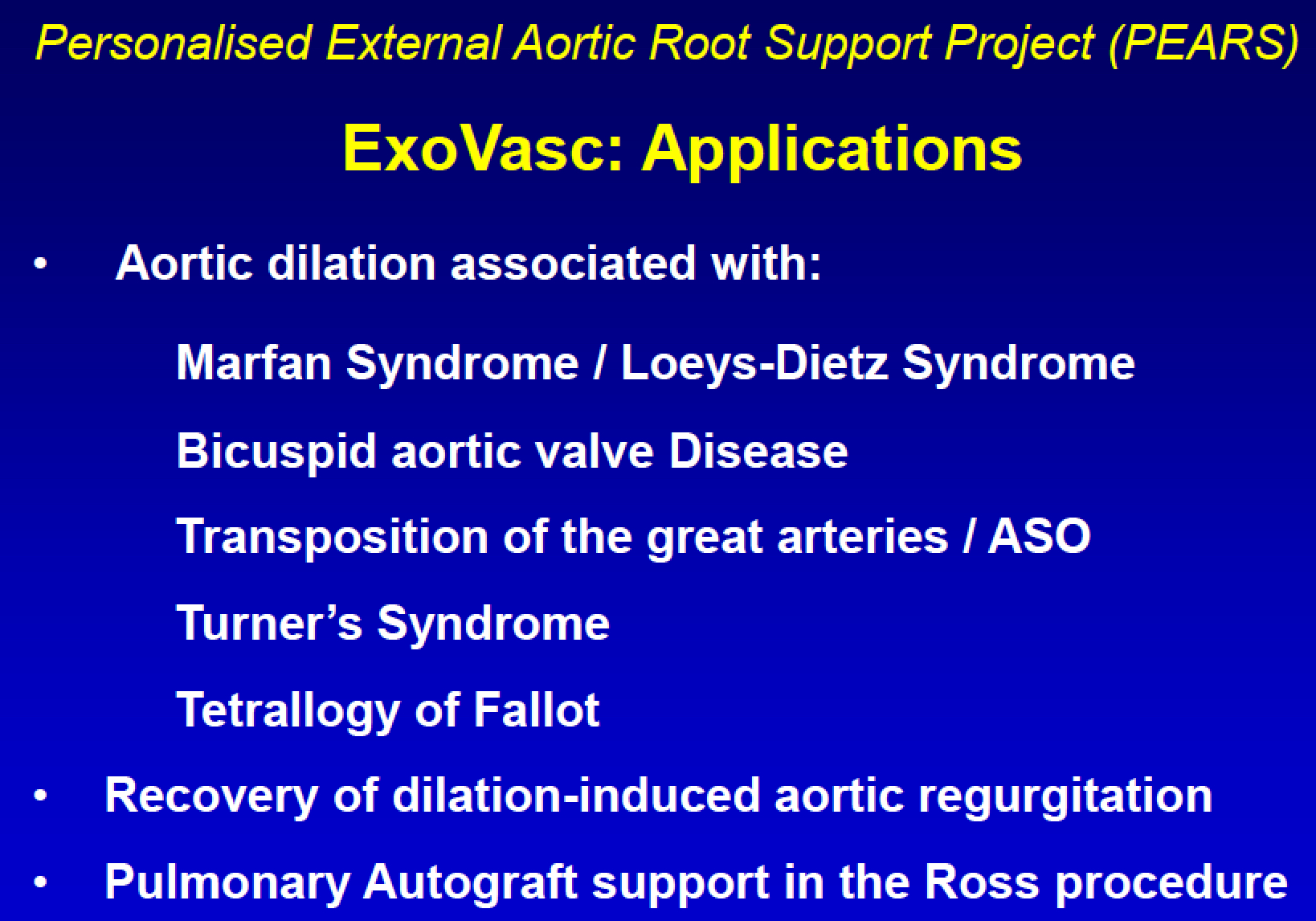
The PEARS Procedure Moving Forward
At present (April 2017), the PEARS procedure is not yet available in the United States.
However, I have been contacted by several patients in the US who have aortic root aneurysms through my other website and who have expressed an interest in the PEARS procedure. They are even considering traveling to the UK to undergo the procedure.
As an excellent example of cross-Atlantic collaboration, Healthcare Corporation of America (HCA), together with its partner HCA Healthcare UK, is putting together an innovative medical tourism program to assist patients in the US with aortic root aneurysms who interested in obtaining the PEARS procedure in London.

In its initial stages, the way this program is shaping-up is that patients with aortic root aneurysms in the US who are potential candidates for the PEARS procedure will coordinate an initial consultation to be evaluated in person by the Heart Team (including yours truly) at TriStar Centennial Medical Center (HCA) in Nashville, Tennessee. After going through a series of evaluations, medical tests and imaging procedures, the results of those tests and consultations will be communicated to the PEARS team in London at London Bridge Hospital.
The team in London will review all of the information and tests results performed in Nashville and determine if the patient is a candidate for the PEARS procedure. If the patient is a candidate for the PEARS procedure, then the London Bridge Hospital team, along with HCA Healthcare UK, will coordinate a schedule for the patient to travel to London to receive the surgery, convalesce for awhile and then return to the US.
Not all of the specifics have been worked out yet, but we are in the process of coordinating those details.
Ultimately, one day, we hope to offer the PEARS Procedure at TriStar Centennial Medical Center in Nashville, TN.
For us to do that, the PEARS technology will have to be offered initially as part of a research trial approved by the Food and Drug Administration. Any new medical device in the US needs to start with this type of process before being offered widely throughout the US.
-
For more information on the PEARS procedure, you can check-out the ExStent website HERE.
-
If you are interested in learning more about the PEARS procedure, feel free to contact me info@badaorta.com.
[***** Update: The transcontinental referral program between TriStar Centennial Medical Center and the PEARS program in London has been dissolved. If you are interested in learning more about the PEARS Procedure, please reach out to me by email info@badaorta.com]
Learn more about aortic root surgery
Make sure to check out my other website to learn more about aortic root surgery and related topics.
Learn more nowAs I have more updates about the PEARS procedure, I will provide them.
Share your thoughts below about the PEARS procedure and feel free to pass this post along so that others with aortic root aneurysms might learn about this novel treatment approach.
Was this post informative?
Subscribe to my newsletter to learn more about the aorta, its diseases, and how to treat them.
Comments
Share your thoughts below — I try to get back to as many comments as possible.